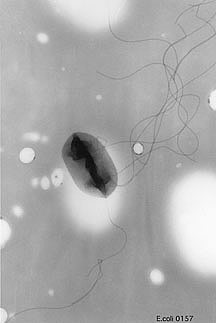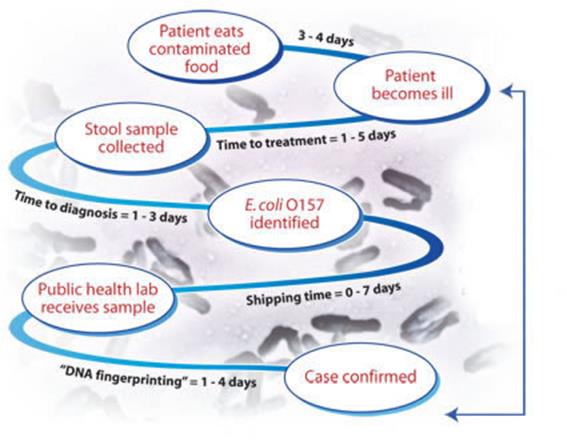Escherichia coli 0157:H7
Most strains of E. coli, which are motile, rod-shaped bacteria, are harmless bacteria and are part of healthy flora that live in the intestines of healthy humans and animals, but there are some pathogenic strains that cause disease. Pathogenic E. coli strains are categorized into pathotypes. There are five main pathogenic serotypes: O26:H11, O103:H2, O111:H8, O145:H28, and O157:H7. These pathogenic serotypes produce a powerful Shiga toxin , also known as a verotoxin,that cause disease in humans. E. coli 0157:H7 has become the most well known and reported of these pathogenic strains found in the manure of cattle.
, also known as a verotoxin,that cause disease in humans. E. coli 0157:H7 has become the most well known and reported of these pathogenic strains found in the manure of cattle.
E. coli O157:H7 was first recognized as a cause of illness in 1982 during an investigation into an outbreak of hemorrhagic colitis associated with consumption of hamburgers from a fast food chain. \\ Provide some more info on this investigation \\
Although most infections are believed to stem come from eating undercooked ground beef, E. coli 0157:H7 contamination can be found in things such as meats, raw milk products, unpasteurized apple cider, produce, and contaminated water.
Epidemiology
According to a study in 2007 from the Department of Animal Biotechnology at the University of Nevada Reno, over the past thirty years, there has been an increase in "the prevalence rates of E. coli O157 infection worldwide. "The prevalence rate ranged from 0.1 to 54.2% in ground beef, from 0.1 to 4.4% in sausage, from 1.1 to 36.0% in various retail cuts, and from 0.01 to 43.4% in whole carcasses….With regard to beef cattle, the prevalence rates of E. coli O157 ranged from 0.3 to 19.7% in feedlots and from 0.7 to 27.3% on pasture."
The results of this global assessment of the beef cattle role in human infection with Shiga Toxin producing E.coli emphasizes the critical need for more control measures to assure beef safety. Access to the full article is available below.
The CDC estimates there are approximately 169,600 E.coli O157:H7 infections each year in the United States. Public health experts can only rely on estimates rather than actual numbers of infections because not all infections are diagnosed; many infected people do not seek medical care; many of those who do seek care do not provide a stool specimen for testing. Because many people do not report infection with E.coli, the CDC estimates that for every E. coli 0157:H7 case reported, there are 26 cases not diagnosed.
| Turn the pages by clicking on the right or left side of each page to learn more about the different EDS models. | ||
Mechanism of Infection
 Japanese researchers at the Research Institute for Microbial Diseases studied the attachment mechanism for E. coli in 2001. The following steps describe the process.
Japanese researchers at the Research Institute for Microbial Diseases studied the attachment mechanism for E. coli in 2001. The following steps describe the process.
- Step 1: A single E. coli bacterium latches on to the surface of an intestinal epithelial cell using long rope or chain-like pili

- Step 2: Next, the bacterium injects receptor proteins called translocated intimin receptors (Tir) into the intestinal epithelial cell. The bacterium then uses an outer membrane protein called intimin to bind to Tir and remains firmly attached to the host cell surface for the duration of the infection
- Step 3: Finally, once these proteins bind, long strands of actin start to form and lengthen directly beneath where the bacterium is bound to the intestinal cell. The bacterium then becomes perched atop a pedestal formed by the intestinal cell and the symptoms of the infection begins. The sudden onset of abdominal pain and severe cramps is believed to be caused from an inflammatory response, which is typically the first symptom of E. coli 0157:H7 infection.
This video gives a great visual explanation for the ways in which E.coli invade intestinal cells:
Transmission
Cattle are reservoirs for Shiga toxin producing E. coli bacteria. E. coli 0157:H7 strains do not make cattle sick because their bodies do not have receptors like humans do for the toxin to attach and replicate. Meat typically becomes contaminated with E. coli during the slaughtering process, when the contents of an animal's intestines and feces are allowed to come into contact with the carcass. Unless the carcass is properly sanitized, the E. coli bacteria are mixed into the meat as it is ground. As much as 2 to 3% percent of domestic cattle carry E. coli 0157 at the time of slaughter.
Shiga toxin-producing E. coli is spread to humans when contamination occurs in food and water. Humans can also become infected if they are directly exposed to livestock on farms or petting zoos. Infection can spread from person to person if proper sanitation methods are not met. Although most reported infections with Shiga toxin-producing E. coli are linked to undercooked ground beef, nearly 25% of outbreaks come from commercial fruit and produce.
The following video clip from the 2008 documentary, Food, Inc. demonstrates the methods for pathogens to spread from cattle to humans during the slaughter process.
Clinical Symptoms
Although a person of any age can become ill from Shiga Toxin-producing E.coli, very young children and the elderly are the most susceptible to developing severe illness. The symptoms of Shiga Toxin E.coli infection can vary from person to person, but the following symptoms are most common:
- Severe and sometimes bloody diarrhea
- Abdominal cramps
- Fatigue, and occasional vomiting.
- Mild fever
\\ Break from paragraphs...little dense in text in paragraphs below...possible abbreviate with some sort of interactivity \\
Symptoms usually appear within 3 to 4 days, but can take up to 8 days to fully recover. Most people recover without antibiotics or other specific treatment in 5-10 days. Hydration is very important in recovery. According to the CDC, approximately 2%-7% of infections lead to hemolytic uremic syndrome, a complication that can lead to acute kidney failure from the abnormal premature destruction of red blood cells. In the United States, hemolytic uremic syndrome is the principal cause of acute kidney failure in children. The death rate for hemolytic uremic syndrome is 3%-5% with intensive care; however, timely and appropriate treatments usually lead to a full recovery for most people. E. coli infection is usually confirmed by the detection of the bacteria in a stool specimen from an infected individual.
E.coli 0157:H7 is a reportable disease both nationally and on a state level. The below graphic demonstrates the timeline between when a person eats contaminated food and when a case is confirmed. The graphic illustrates the series of events that takes plae between the time a person is infected and the time public health officials can determine that the person is part of an outbreak. Public health officials work hard to minimize the gap between when a person gets sick and when that person is confirmed to be part of an outbreak although some delay is inevitable.

Sources
Outbreaks of E.coli 0157:H7 continue to happen each year. For the past two years in a row, produce has been the main source of contamination. The most recent E. coli O157:H7 outbreak reported by the CDC as of November 19th was due to a contamination of ready-to-eat-salads. Thirty two people reported infection in four states: Arizona, California, Texas, and Washington; seven were hospitalized. In 2012, an outbreak of E.coli 0157:H7 from organic spinach and spring mix blend led to thirty three infections and thirteen hospitalizations in five states.
For a detailed look at all outbreaks since 2006, visit the CDC's website, Reports of Selected E. coli Outbreak Investigations.
| Click below the question to view the answer. | ||


